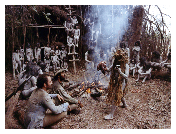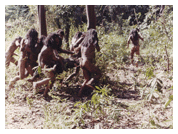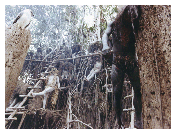|

(aka "the tree people," the "foot tribe")
|

Yanomamo
Warrior
|
No white man has ever seen them, or the ones who have, never live to tell about it. What
is known about the Yanomamo is from diary entries from missing anthropological expeditions,which have been recovered through trade with neighboring villages, and from the few
Yanomamo who have escaped the jungle and moved to bigger cities in the southern Venezuela
area.
In total, the Yanomamo number in the thousands in 200 to 250 widely scattered villages in
the tropical forest of the Amazon, between Venezuela and Brazil. The Yanomamo
(or
"tree people," also known as the "foot tribe") get their name from the villages
constructed of "shabonos." The village looks like one big communal tree house at
first sight, but is actually a series of individual houses or apartments connected
together. The name "tree people" and "foot tribe" is also attributed to the
Yanomamo due to their travel means (by foot as opposed to by river) and they live at higher
altitudes away from the rivers or swamps (thereby avoiding the seasonal flooding that
occurs in the region).
|

Yanomamo Women
|
The Yanomamo are typically hunters and gatherers who are quite adept at gardening --
plantains (cooking bananas) being the number one food source and crop. The
Yanomamo have
amazingly enough, withstood the tests of modern mankind and so-called progress - due to
their isolation in the wilds of the jungle - managing to retain their often bizarre rituals
, cultural rites, warfare between tribes, and basic day-to-day existence without the
external interference or condemnation by western civilization.
The tribes have a very caustic, warlike relationship among each other within the jungle --
wars typically come about as a result of a need for resources, especially women, and/or
the bad vibes or bad magic between one tribe over another. If a baby dies in a village,
it is commonly thought that a neighboring village shaman (voodoo doctor, spiritual or
political chief of a village) performed some malevolent voodoo ("hekura") to the other
rival village, causing the stealing of the "soul" of the child, and ultimately the death.
|

Dinner with the Yanomamo
|
The Yanomamo are historically a tribe of "endocannibals" (which means that they eat their
own people). This rare form of cannibalism usually only occurs after death. The body of
the deceased is set afire in a remote region away from the village (so as not to dirty the
village or its food) and then the remaining bones and ash are pulverized into a fine powder
which is mixed into a beverage (often juice from the plantain). The beverage is then
consumed by the deceased person's relatives. This "drinking of the dead" is thought to
be the way for the deceased's soul to enter the body of their living descendants, thus
providing spiritual and physical strength to combat the evils of the jungle. The act of
cannibalism may seem shocking to most Westerners, however a form of cannibalism called
"theophagy" is practiced by many Catholics on a weekly or daily basis. The Communion
(the symbolic eating of the body and blood of Christ) may seem like a natural ritual to
us, but may make little sense to the Yanomamo. They prefer the real thing.
Although the Yanomamo are known as endocannibals (choosing to eat from their own tribe)
they are an aggressive and violent clan who have very tumultuous relationships with anyone
perceived as being "other than" their tribe, or towards out-and-out foreigners. Anyone
discerned as being "other" than the tribe, is considered to be subhuman. The laws and
ethics that may keep a village from succumbing to warfare within its own walls, thereby
do not apply to anyone perceived as being subhuman. In other words, war is hell and the
Yanomamo will do anything including kidnapping, rapping, killing and abusing people from
opposing tribes.
Violent acts also occur within the tribe -- women are frequently beaten by clubs (although
unchivalrous to we Westerners, it is an attempt by the Yanomamo husband to show other
village men his strength and virility). If a woman is found to have been adulterous, as
punishment the husband may chop off the woman's ears or a portion of her buttocks with a
machete. This seems horrific in light of recent gains by women in most parts of world --
but it is a culture that has its own rules and regulations which are untainted by the
touch of outside civilization. Women are not given many rights in the village, including
their exclusion from some of the cooking (they are thought to be too clumsy with the
clay pots) which the men handle instead. The women are not given any respect until they
reach the ripe age of 30, at which point they laugh and tell dirty jokes amongst one another (often about men's penises flopping out of their tiny string thongs, which is a
source of great embarrassment for the younger Yanomamo men who are just learning to master
tying their penises up to their waists). From the Yanomamo male point of view, the older
the woman, the more highly she is held in esteem -- the more she is allowed to express her
viewpoints and even joke and make fun of her male counterparts, without fear of reprisal.
In all fairness, brothers of a woman often defend her from the beatings of a particularly cruel husband. Women are also not typically killed during the frequent war raids on other
villages, as it is seen as poor form -- a faux pas.
|

Rampaging Yanomamos
|
Culture of Violence: the raid on outside villages is complete warfare for the
Yanomamo.
The idea is that the tribe members try to sneak up on their unsuspecting victims and
attempt to kill one or more of them, then run away as fast and as quietly as they can
without being detected by the raided villagers. If any of the raiding tribe are killed
by the ones that they have raided, the whole event is considered a failure. Another
benefit of a successful raid is the rape and/or capture of the other tribe's women
(women -- whose numbers among some tribes are low). For example, if some members of one
tribe stumble upon a man and wife away from their village (a rival tribe) they will kill
the husband and take the woman for themselves. The machetes, axes and sometimes shotguns
were obtained by the natives in trading or by larcenous acts upon some of the missionaries
who dare to build along the Orinoco river.
|

Fates of an Enemy
|
The weapons of choice for the Yanomamo
are the machete, axe, and bows and arrows with
curare-poisoned "husu namo" points. The point has one-inch intervals where they are
rather purposely weakened, giving the arrows the ability to break off into the body of
the victim, enabling the poison to be absorbed and making it extremely difficult to remove.
The Yanomamo also use 6-foot-long spear-like arrows.
The Yanomamo take hallucinogenic drugs almost on a daily basis. All drugs they use are
commonly available from the jungle: from the yakowana tree (whose bark is ground into a
snuff powder) and from the seeds of the hisiomo tree (which are packed into cigar-shaped
wads and traded amongst the friendly villages). In powder form, all drugs are referred to
as "ebene" by the tribes. The men take ebene every day, paint themselves red and put on
feathers. A long hollow tube called a "mokohiro" is used to blow the powder into another
Yanomamo's nostrils. The drug-induced Yanomamo then awaits visits by the spirits.
Property of Rio Ocora Police Department. Used with Permission. |
|